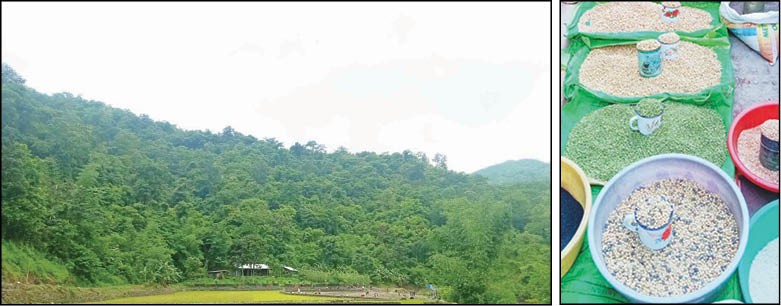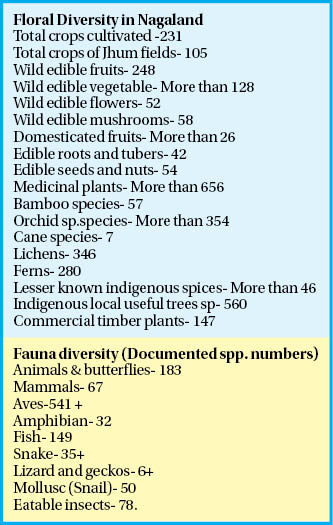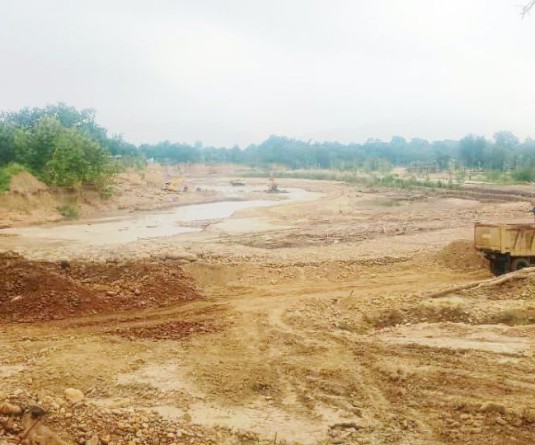(Left) A Nagaland Government report states that the flora and fauna in Nagaland is being endangered by reckless deforestation and other human activities. (Right) Pulses for sale at a local market in Nagaland. A report from the Nagaland Department of Environment, Forest and Climate Change says that deforestation threatens sustenance of produce.

Our Correspondent
Kohima | January 10
Nagaland lies in the 10th distinct bio-geographic zone under one of the identified 18 mega hot spots in the world with reference to threats to biodiversity. However, human activities like reckless deforestation have been endangering many of the state’s flora and fauna, as per a government report.
According to Annual Administrative Report 2019-2020 of the state Department of Environment, Forest and Climate Change, Nagaland “has the finest tropical, subtropical evergreen forests and unique broad leaved moist temperate forests.”
The floral vegetation and fauna elements represent the transition zone of India, Indo-Malayan and Indo-Chinese bio-geographical region. Many ancient angiosperms and primitive flowering plants are present and the area is considered as a cradle of flowering plants, the report stated.
The region is also the centre of origin of some rice varieties and secondary origin of citrus, chilly and maize etc.
The report observed that the local populations are intricately involved with the forests for their sustenance be it agriculture, timber, small, timber, day to day use items or medicinal plants etc.
These forest products are also their main source of economy. Therefore, when the main stay of the people is dependent on forest, destruction of forests is eminent, thereby endangering many valuable species, it stated.
It said that the rich biodiversity of the state is dwindling year by year due to the primitive method/practice of cultivation (i.e. slash burning) and most of species, both flora and fauna, appear to be endangered due to heavy biotic pressure/interference and reckless deforestation.

Endangered flora species
Dipterocarpous macrocarpous (Hollong), Shorea assamica (Makai), Rhododendron Spp, Mesua ferra (Nahar), are some of the rare and endangered species identified in the report. Panax gensing (Gensing) which is found only in Tuensang district at higher altitudes is also listed as an endangered species.
The report stated that Aquilaria agallocha (Agar) is also an endangered species.
As per the report, some of the rare and endangered species of orchids available in Nagaland are as follows; Thunia 1 spp, Arundinaria graminifolia (Bamboo orchid), Renenthera (Red vanda), Rhynchosylis (fox tail), Pleoni, Phauis (ground orchid) 2 spp, Paphiodedilum 1 spp, Cymbidium tigrinum 1 spp.
Fauna
Among others the largest Asian mammal, elephant is an endangered species along with the Melurses ursinus (Sloth Bear) Prionodon pardicolor (Spotted linsang, Tiger-civet), Panthera Tigris (Tiger) and Macaca assamensis (Tailed Pig). The Gaur or Indian Bision in habitats in the Intangki National Park and Fakim Wildlife Sanctuary and other hilly areas are facing extinction from Nagaland and the different hornbills and tortoises are also endangered, the report stated.
Community conservation
The report stated that the conservation of common pool resources by local communities has a long history in Nagaland.
Such conservation initiatives have been traditionally practiced in different forms with varied institutional structures.
Several such practices are initiated by community organization like youth organization, women groups, religious/cultural groups and village councils with the community as spontaneous reaction to address the problems of forest/environment degradation.
Nagaland has 407 documented Community Conserved Areas (CCAs) out of which 343 CCAs which constitute 84.3% are self initiated and 62 (15.2%) are being initiated by the forest department.


.jpg)



